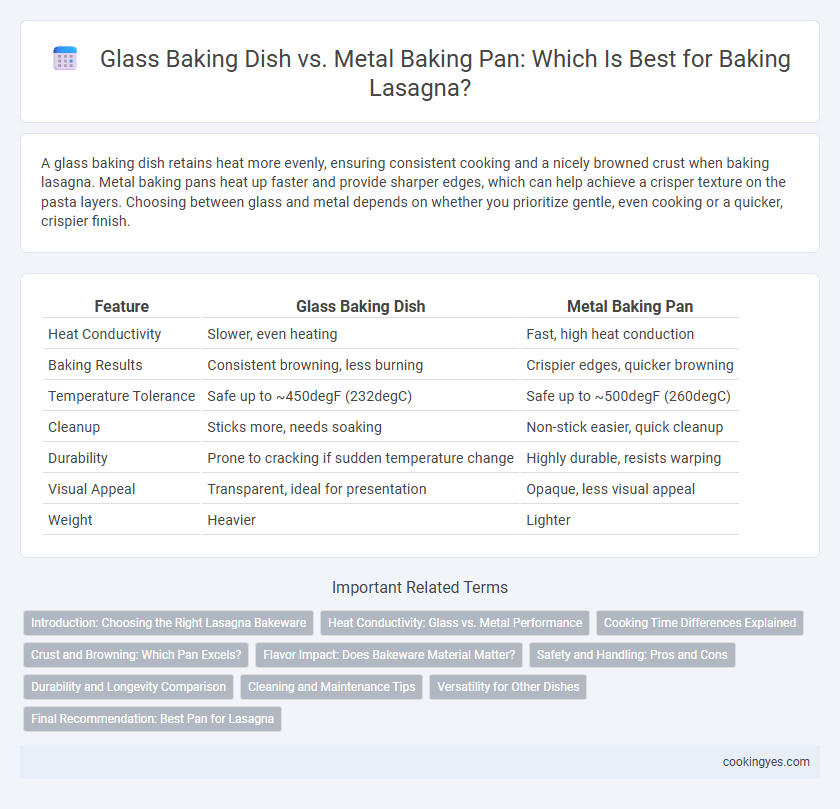A glass baking dish retains heat more evenly, ensuring consistent cooking and a nicely browned crust when baking lasagna. Metal baking pans heat up faster and provide sharper edges, which can help achieve a crisper texture on the pasta layers. Choosing between glass and metal depends on whether you prioritize gentle, even cooking or a quicker, crispier finish.
Table of Comparison
| Feature | Glass Baking Dish | Metal Baking Pan |
|---|---|---|
| Heat Conductivity | Slower, even heating | Fast, high heat conduction |
| Baking Results | Consistent browning, less burning | Crispier edges, quicker browning |
| Temperature Tolerance | Safe up to ~450degF (232degC) | Safe up to ~500degF (260degC) |
| Cleanup | Sticks more, needs soaking | Non-stick easier, quick cleanup |
| Durability | Prone to cracking if sudden temperature change | Highly durable, resists warping |
| Visual Appeal | Transparent, ideal for presentation | Opaque, less visual appeal |
| Weight | Heavier | Lighter |
Introduction: Choosing the Right Lasagna Bakeware
Glass baking dishes provide even heat distribution, allowing lasagna to cook uniformly and retain moisture for a tender texture. Metal baking pans heat faster and promote a crispier, golden-brown crust on the edges, enhancing flavor through caramelization. Selecting the right bakeware depends on desired texture and heat conduction preferences, influencing the overall lasagna quality.
Heat Conductivity: Glass vs. Metal Performance
Glass baking dishes provide even heat distribution, which helps lasagna cook uniformly without hot spots, but they take longer to heat up compared to metal pans. Metal baking pans, especially aluminum, offer superior heat conductivity, allowing faster cooking and crispier edges in lasagna due to efficient heat transfer. Choosing between glass and metal depends on whether slow, even cooking or quick, intense heat is preferred for the desired lasagna texture.
Cooking Time Differences Explained
Glass baking dishes retain heat longer and distribute it more evenly, resulting in slower cooking times for lasagna compared to metal baking pans. Metal pans conduct heat quickly, producing a faster, often crispier bake but may require reduced cooking time to prevent overcooking. Adjusting baking time and temperature based on the material ensures perfectly cooked lasagna with desirable texture and flavor.
Crust and Browning: Which Pan Excels?
Metal baking pans excel at creating a crispier crust and deeper browning on lasagna due to their superior heat conduction and ability to distribute heat evenly. Glass baking dishes cook more slowly and retain heat longer, resulting in a softer crust with less browning but a more insulated, even bake. For a perfectly browned, crispy top, a metal pan is preferred, while glass is ideal for gentle, thorough cooking without risking burnt edges.
Flavor Impact: Does Bakeware Material Matter?
Glass baking dishes distribute heat evenly, promoting consistent lasagna cooking and enhancing flavor by allowing slow caramelization of cheese and sauce edges. Metal baking pans conduct heat faster, creating crisper layers and slightly browned crusts that intensify taste and texture. Choosing between glass and metal bakeware directly influences lasagna's flavor profile through variations in heat retention and browning effects.
Safety and Handling: Pros and Cons
Glass baking dishes offer even heat distribution and allow visual monitoring of lasagna while baking, but their brittleness makes them prone to breaking and requires careful handling. Metal baking pans heat up faster and provide a crispy crust due to better heat conduction, though they can cause hot spots and may require oiling to prevent sticking. Safety-wise, glass remains heat-resistant without leaching chemicals, while some metal pans might react with acidic tomato sauce, potentially affecting flavor and safety.
Durability and Longevity Comparison
Glass baking dishes offer excellent durability due to their resistance to scratches, staining, and reactive metals, maintaining clarity and structural integrity over many uses. Metal baking pans, typically made from aluminum or stainless steel, provide superior heat conduction and are less prone to cracking but may warp or corrode with prolonged exposure to high temperatures and acidic ingredients. For longevity, glass dishes withstand frequent dishwasher cycles and chemical exposure better, while metal pans require careful maintenance to prevent rust and degradation.
Cleaning and Maintenance Tips
Glass baking dishes for lasagna are non-porous and resist staining, making them easier to clean with warm soapy water or a soaked baking soda paste, while metal pans may require scrubbing to remove baked-on food. Using non-abrasive sponges preserves the dish surface and prevents scratching, especially important for glass to maintain clarity and for metal to avoid rust. Applying a light coating of cooking spray before baking can reduce food adhesion, simplifying maintenance for both glass and metal pans.
Versatility for Other Dishes
Glass baking dishes retain heat evenly, making them ideal for casseroles, roasting vegetables, and baking desserts, enhancing flavor development and presentation. Metal baking pans heat up quickly and offer superior browning, perfect for roasting meats, making sheet cakes, and broiling, thanks to their responsive heat conduction. Choosing between glass and metal depends on versatility needs: glass excels in multi-purpose oven-to-table use, while metal provides high-heat performance for diverse cooking techniques.
Final Recommendation: Best Pan for Lasagna
Glass baking dishes provide even heat distribution and retain heat longer, resulting in a well-cooked and evenly browned lasagna. Metal baking pans heat up quickly and produce a crispier crust, ideal for those who prefer a crunchy texture. For the best lasagna, a metal baking pan is often recommended due to its superior browning capabilities and faster cooking time.
Glass baking dish vs Metal baking pan for baking Infographic

 cookingyes.com
cookingyes.com